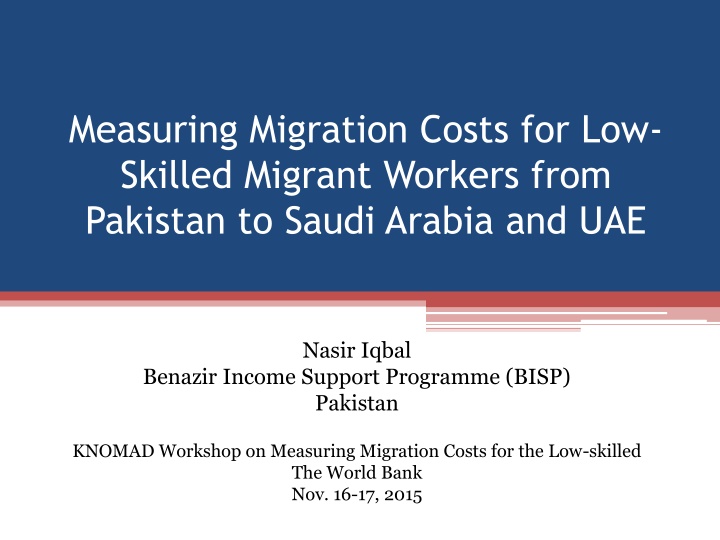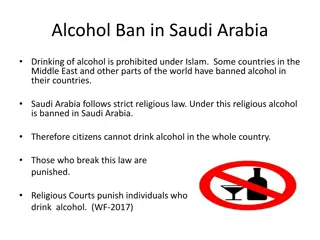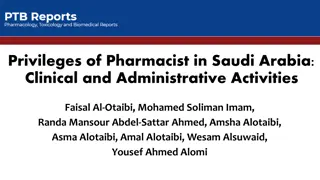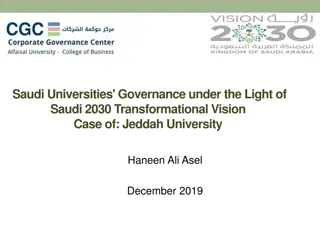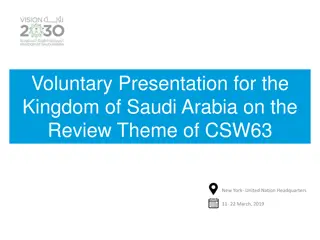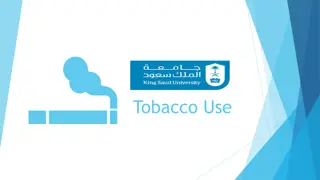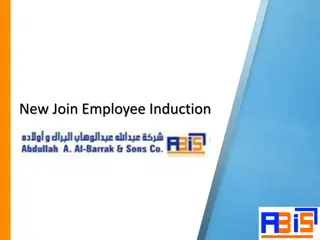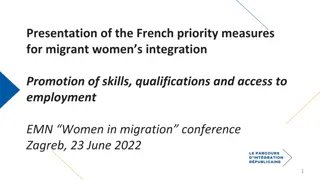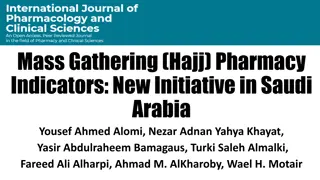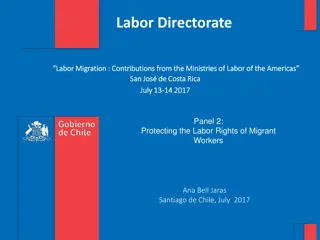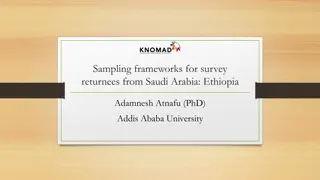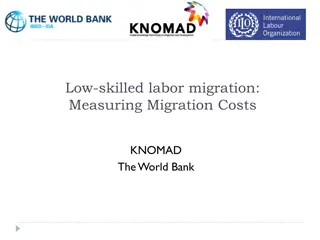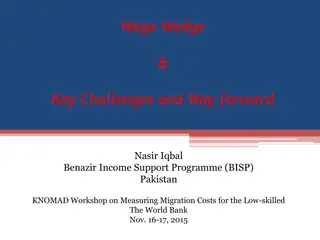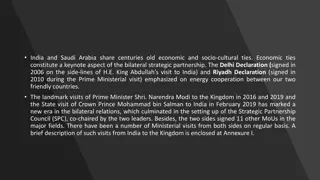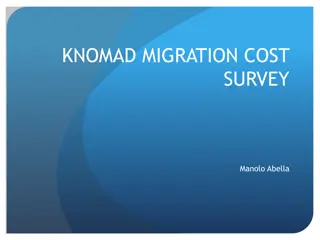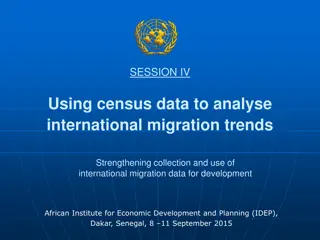Measuring Migration Costs for Low-Skilled Migrant Workers from Pakistan to Saudi Arabia and UAE
This study discusses the migration costs and patterns of low-skilled migrant workers from Pakistan to Saudi Arabia and the UAE. It covers the background, regional variations, skill composition, and challenges faced in data collection. The data reveals the significant influx of Pakistani workers to the Gulf states and highlights the dominance of low-skilled labor in this migration flow.
Download Presentation

Please find below an Image/Link to download the presentation.
The content on the website is provided AS IS for your information and personal use only. It may not be sold, licensed, or shared on other websites without obtaining consent from the author.If you encounter any issues during the download, it is possible that the publisher has removed the file from their server.
You are allowed to download the files provided on this website for personal or commercial use, subject to the condition that they are used lawfully. All files are the property of their respective owners.
The content on the website is provided AS IS for your information and personal use only. It may not be sold, licensed, or shared on other websites without obtaining consent from the author.
E N D
Presentation Transcript
Measuring Migration Costs for Low- Skilled Migrant Workers from Pakistan to Saudi Arabia and UAE Nasir Iqbal Benazir Income Support Programme (BISP) Pakistan KNOMAD Workshop on Measuring Migration Costs for the Low-skilled The World Bank Nov. 16-17, 2015
Road Map Background Spread Destination, Regional variations, Skill composition Methodology What is cost? What is low skill? Sampling framework Data collection procedure Migration COST Key Challenges
Background Pakistan the second largest labour sending country (after India) in South Asia Between 1971-2015, more than 8 million Pakistani have officially proceeded abroad for employment Migration from Pakistan reached a new peak after 2011 During the five years (2011-2015), more than 3 million people proceeded abroad for employment Out of this total labour migration about 96% have proceeded to the six GCC member states Saudi Arabia, UAE, Kuwait, Oman, Qatar and Bahrain
Spread Destination, Regions, Skill Composition
Distribution of Migrant Workers: Middle East Bahrain, 1.75 Qatar, 1.33 Kuwait, 0.29 Oman, 9.84 Saudi Arabia, 48.54 U.A.E., 38.24 Source: BEOE, 2015
Regional Variations 60.0 53.7 51.5 50.0 40.0 30.0 27.5 22.2 20.0 12.9 8.1 10.0 6.8 4.8 4.8 2.9 2.2 1.3 1.2 0.1 0.0 Punjab Sindh KPK Baluchistan AJK GB FATA & ICT Percentage Population Source: BEOE, 2015
Skill Composition Highly Qualified , 1.8 Highly Skilled, 4.8 Skilled , 43.2 Un-Skilled , 43.6 Semi Skilled , 6.6 Source: BEOE, 2015
Share of Low Skilled Workers in Total Migration (Only Laborer and Agriculturist) 60.0 50.1 47.7 50.0 46.9 44.6 44.2 43.9 43.0 42.2 40.6 40.4 38.5 40.0 30.0 20.0 10.0 0.0 2005 2006 2007 2008 2009 2010 2011 2012 2013 2014 2015
Measuring migration Cost Migration costs refer to the costs associated with workers national border crossing, and consists of recruitment fees (including sale of visas and other job- matching fees), document costs, and transportation costs. Migration cost components include: Documentation (passport, visa, medical exam report, security clearance), Transportation (internal and international), Training (skills and language); Recruitment (job information; brokerage fees; service charges) fees; Guarantee deposits; insurance schemes and welfare funds; informal payments; opportunity costs; and also the costs to borrow money to finance migration
Sampling Framework Definition of migrant respondent The migrant who has worked or is working in Saudi Arabia or in UAE; went abroad (Saudi Arabia or UAE) in January 2011 or after; is a legal migrant worker (e.g. has gone through a regular channel); has returned home (to Pakistan) after the completion of their jobs at the time of survey, or, is visiting his family in Pakistan on holidays or has returned home with a new contract to go abroad soon; has worked or working in Saudi Arabia or UAE in low skilled categories of occupations like construction and agriculture sectors
Sampling Framework Identification of respondents The major challenge for the survey was the identification of respondents as defined earlier Steps involve in identification of respondents Step 1: Identification of Districts Pakistan is divided into four provinces and three regions including FATA, GB & AJK. There are more than 146 districts in these provinces and regions. More than 60% migrated from only 20 districts. We identified high migration districts on the basis of number of migrants went to GCC countries during 1981-2015. Survey is conducted in 6 high-migration districts
Sampling Framework Selected Districts Rawalpindi and Gujrat from North Punjab Gujranwala and Sailkot from the central Punjab; Mardan and Charsada from KPK
Sampling Framework Step 2: Identification of targeted migrants Purposive/snowball sampling strategy was used To obtain required respondents an extensive listing process was undertaken with the assistance from key informants, migrants visiting the offices of regional Protector of Emigrants and return migrants Number of Respondents Listed in each District District Name Sailkot Gujranwala Gujrat Rawalpinidi Mardan Charsada Total No of Respondents 150 151 155 110 151 160 877
Data Collection Procedure For data collection three teams were formulated: Team A for Central Punjab (Gujranwala and Sailkot); Team B for North Punjab (Rawalpindi and Gujrat); Team C for KP (Mardan and Charsada) Each team consists of two enumerators including head enumerator (supervisor). One week training is conducted by the two trainers to develop the capacity of enumerators and supervisors The training of all enumerators helps to go thought each question in the questionnaire to ensure that the enumerators are able to guide the survey participants through each question
Data Collection Procedure This training session covers the following tasks: Training of the World Bank s Computer Assisted Personal Interviewing system (CAPI) and use of tablets to conduct survey; Field test 1 carried out in surrounding areas of Rawalpindi to review the performance of the enumerators along with the validity of questionnaire Field test 2 carried out after incorporating the suggestion regarding the adaptation of questionnaire and after improving the skill of the enumerators and supervisors.
Field Survey 620 interviews were conducted from migrants in selected districts, ensuring more than 100 interviews in each districts Sample Distribution across Districts District Name Rawalpindi Mardan Charsada Sailkot Gujrat Gujranwala Total Sample Size 109 101 104 101 103 102 620 Share 17.58 16.29 16.77 16.29 16.61 16.45 100.00
Socio-economic characteristics of the sampled migrants Indicator Average Age of Migrant (years) Marital Status (%) Unmarried Married Educational Status(%) No Education Primary Education Secondary Education Tertiary Education Average number of dependents (No.) Value 29.2 41.9 58.1 10.5 33.1 46.5 10.0 8.0
Cost: Average Migrant Cost (US$) Regions Pakistan District wise Rawalpindi Mardan Charsada Sailkot Gujrat Gujranwala All Sample 3489 Saudi Arabia 4290 UAE 2358 3238 4548 3302 3995 3365 2640 3442 4904 3858 4663 4464 4278 2982 2590 2432 2853 1863 1896
Cost: Component wise (as % share of total) All Sample Components Cost US $ Saudi Arabia 3493.8 342.5 All Sample UAE Saudi Arabia 81.4 8.0 UAE Visa Fee Agent Cost International Transport Inland Transport Passport Fee Medical Fee Contract Fee Others Insurance Briefing Fee Clearance Fee Exit Fee Welfare Fund Total 2823.6 271.3 1818.4 164.1 80.9 7.8 77.1 7.0 249.4 60.7 46.2 45.5 30.8 14.6 10.9 6.6 0.9 0.9 0.1 3489 248.2 73.9 48.3 60.0 27.5 22.3 10.9 5.4 0.8 1.1 0.1 4290 251.1 41.1 43.1 23.9 35.8 3.1 11.0 8.5 1.0 0.6 0.1 2358 7.1 1.7 1.3 1.3 0.9 0.4 0.3 0.2 0.0 0.0 0.0 100 5.8 1.7 1.1 1.4 0.6 0.5 0.3 0.1 0.0 0.0 0.0 100 10.6 1.7 1.8 1.0 1.5 0.1 0.5 0.4 0.0 0.0 0.0 100
Cost: Migration Cost against different financing sources All 2922 3790 Saudi Arabia 3926 4444 UAE 1907 2679 Self Financed Borrow Money Source of Finance Family Member Friend/Relatives Money Lender Bank Recruiter 3799 3677 4180 5030 5038 3182 4404 4171 6421 6477 4347 2400 4244 2247 2519
Fundamental Causes of High Migration Cost Source of Job information and the functioning of a visa market in Pakistan 70.0 63.0 56.6 60.0 52.1 50.0 42.9 37.1 40.0 29.0 30.0 20.0 5.0 4.5 4.2 10.0 2.9 1.7 0.9 0.0 Relative/Friend Individual recruiter/ broker Manpower agency Other* All Saudi Arabia UAE Source of Job Relative/Friend Individual recruiter/ broker Manpower agency Other* ALL 3776 2482 1735 3435 SA 4491 4237 2666 2700 UAE 2204 2813 2268 1321
Fundamental Causes of High Migration Cost Previous foreign employment experience 5000 With previo us emplo yment exper eince 14% 4308 4500 4143 4000 3580 3500 2926 3000 2455 2500 1930 2000 1500 First time foreig n emplo yment 86% 1000 500 0 All Saudi Arabia UAE First time foreign employment With previous employment expereince
Fundamental Causes of High Migration Cost Wage wedge 4540 Q10 888 4303 Q9 579 4508 Q8 471 4374 Q7 390 3119 Q6 307 3130 Q5 242 2947 Q4 196 2665 Q3 160 2520 Q2 111 2682 Q1 9 0 1000 2000 3000 4000 5000 Average Cost Avg. Wage Differential
Migrant Costs: Key Challenges Identification of Respondent Law and order situation Choice criteria (only low skill) Time period (after 2011) Cost estimates? Majority knows LUMP SUM not breakdown Role of Friends/Relatives Semi-illegal market for visas operate through Friends/Relative and individual agents Lesser job opportunities in home countries may increases the demand for foreign employment hence cost of migration
The Way Forward The central conclusion of this analysis is that large benefits associated with the overseas migration of low-skilled workers are eaten up as visa fee by an unscrupulous group of people who trade in the selling of visas. But? How are these illegal profits collected and how this large semi-illegal market for visas works needs much more study?
The Way Forward Pakistan has developed institutions overtime to regulate overseas temporary migration for employment. The exploitation of low-skilled workers through visa trading in the presence of the official regulating machinery is extremely disappointing but also shows that the faith in government in solving problems may not be well placed. Indeed the more controls are put in place the higher can be the costs which are extracted by those officials who are tasked with implementing these countries. This points to the enormous challenges that any reforms to reduce these costs will face.
